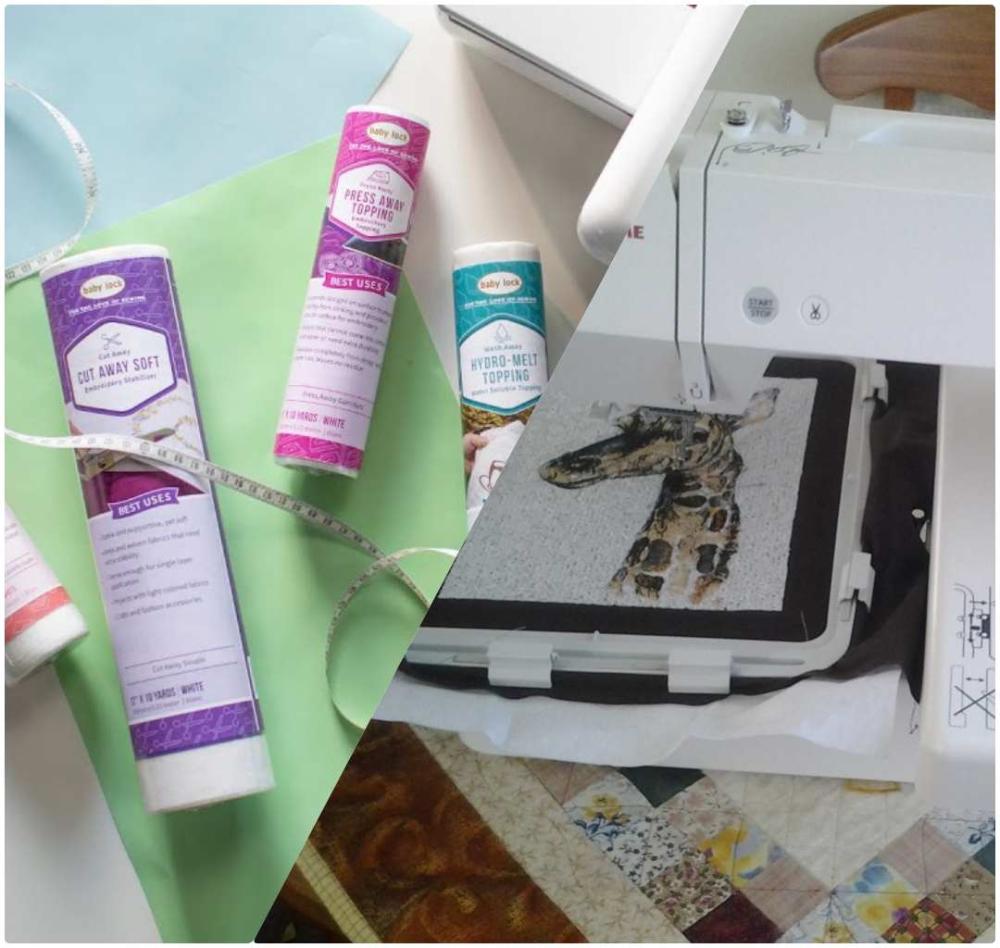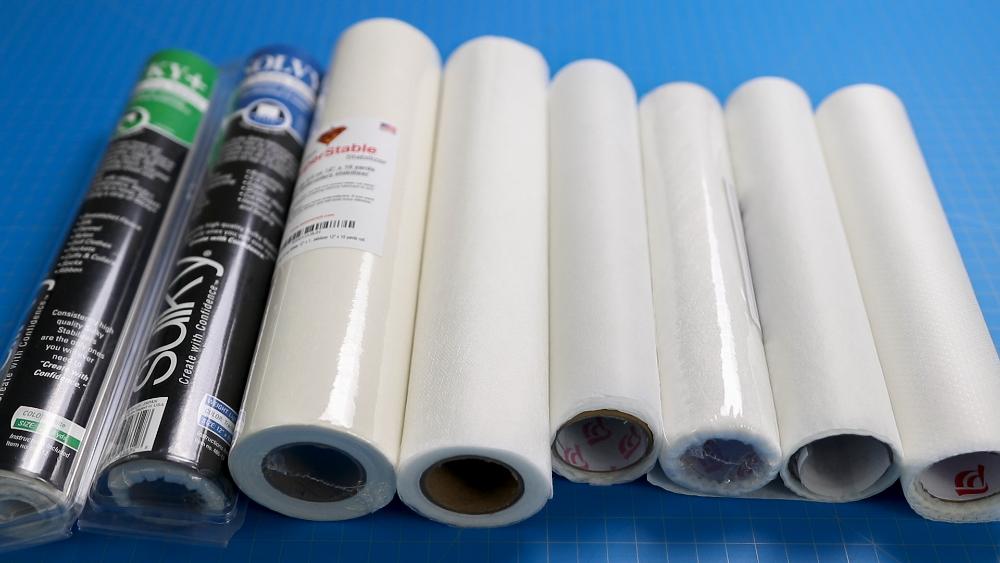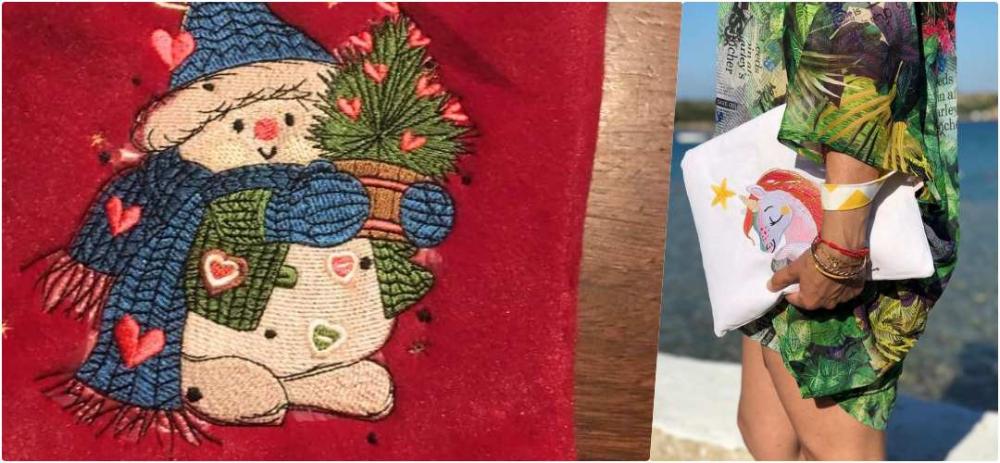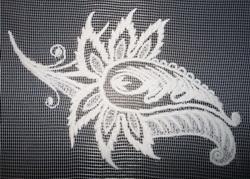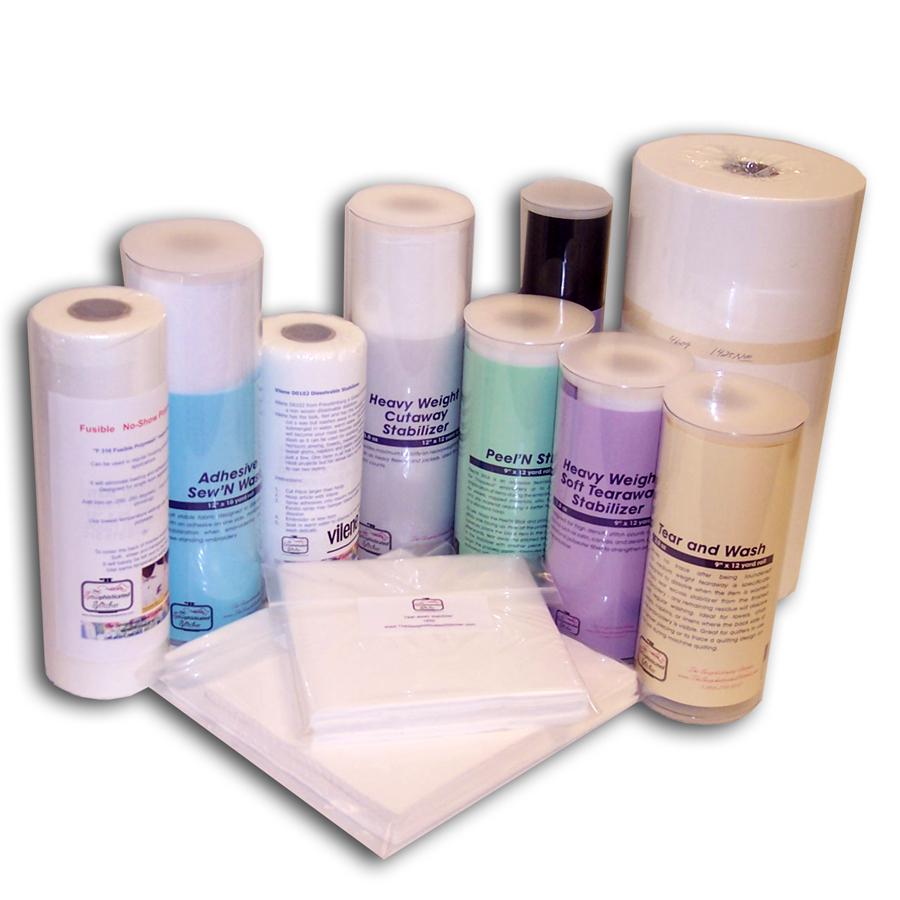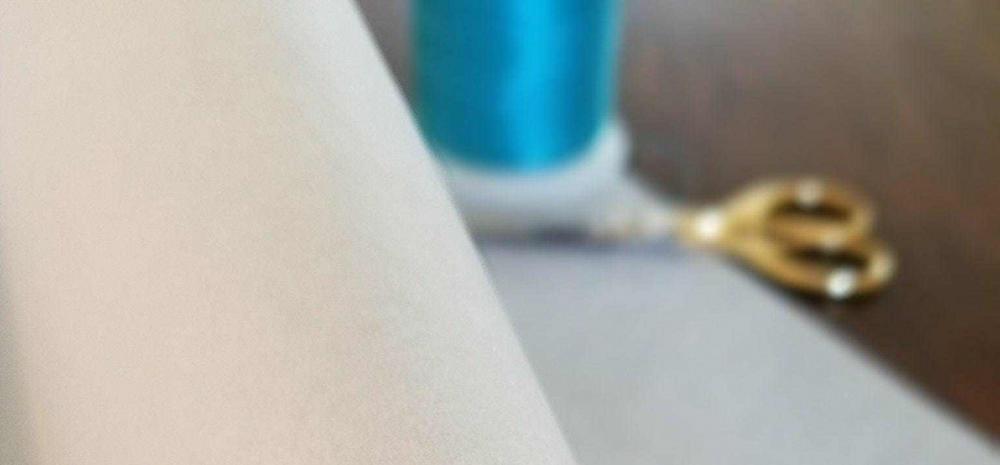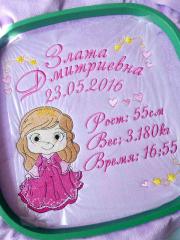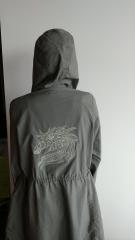Search the Community
Showing results for tags 'stabilizer'.
-
Are you new to the world of machine embroidery? One of the first terms you'll hear is "backing" or "stabilizer." Embroidery backings are essential for creating stability when machine embroidering on any fabric, particularly stretchy knits and polyester performance shirts. When it comes to starting an embroidery project, choosing the right stabilizer is one of the most important decisions you'll make. Proper stabilization is the foundation of excellent embroidery, and choosing the wrong stabilizer can lead to poor results. In this article, we'll take a closer look at embroidery stabilizers and help you make informed decisions when starting your next embroidery project. Fashion teddy bear embroidery design What is an Embroidery Stabilizer? If you've ever worn an embroidered shirt, you've probably seen embroidery backing before. It's the fabric that sits behind the stitches, providing support during the embroidery process. Embroidery backings are typically wet-laid nonwovens, which means they're made up of random fibers held together by a binder. The non-directional nature of nonwoven backings makes them strong and stable for use as embroidery stabilizers. However, it's important to use nonwovens specifically designed for machine embroidery. Some people advocate using things like coffee filters, newspaper, or paper towels as backing, but these products can break up during embroidery, causing excessive lint in your bobbin cases and machine parts. What are the Different Types of Embroidery Backing? There are three major types of embroidery stabilizers: Cut Away, Tear Away, and Water Soluble. Most backings come in different weights, usually advertised as ounces per square yard. The heavier the backing, the more stability it usually provides. A good backing supplier will sell many different weights, types, and sizes of stabilizer in both pre-cut sheets and on rolls. Mosaic horse embroidery design Cut Away Backings Cut Away backings provide the most stability and remain on the garment, keeping it stable after being embroidered. With a Cut Away backing, after you finish embroidering, you cut away the excess backing close to the design, and the rest stays on the fabric. For beginner embroiderers, we always recommend using a cutaway with most unstable fabrics and anything you're going to wear. Cut Aways are inherently more stable and will be more forgiving with some of the mistakes you make when you're new to machine embroidery. They're a great choice for stretchy knits and polyester performance shirts because they prevent embroidered designs from stretching with repeat wearing and washing. Tear Away Backings Tear Away backings are removed, or torn away, from the fabric after embroidery. They're generally less stable than cutaways and are used for light support, on less stretchy fabrics, and items where the back may be visible, like towels and linens. With Tear Away stabilizers, you just tear away the backing when you finish embroidering. For large commercial shops, this can speed up the entire embroidery process when encountering large jobs. Tear Away can also be used in conjunction with a Cut Away to provide additional support during embroidery without adding additional bulk to the finished garment. Water Soluble Stabilizers Water Soluble Stabilizers dissolve when immersed in water. There are two types of Water Soluble Stabilizers (WSS) – a film type called Badgemaster and a nonwoven fabric type called Vilene. Both work the same way, and it's personal preference which one you use. WSS should mostly be used for free-standing lace (FSL) type applications, where you need the backing to 100% disappear. Remember, this backing dissolves in water, so if you use it as a regular stabilizer, you'll lose stabilization under the
-
Embroidery is an art form that requires patience, skill, and the right materials to achieve beautiful results. One crucial component that every experienced embroiderer knows is stabilizer. The use of stabilizer helps to support your fabric and thread, ensuring that your design is aligned, and your fabric doesn't distort or pucker. In this article, we'll answer some of the most common questions about stabilizers and provide you with a machine embroidery stabilizer guide to help you get professional results. What Brand Of Stabilizer Should You Use? When it comes to choosing the right brand of stabilizer, we recommend buying from a reliable embroidery source online or supporting your local dealer and using the brand they sell. In most cases, we shop for stabilizers based on price point rather than who they're made by because most stabilizers are created by a handful of main manufacturers and then white-labeled by different embroidery brands. However, avoid purchasing stabilizers from "big box stores" such as Walmart or Michaels. While you may save a few bucks, the quality of the stabilizer is usually subpar, and you won't get a consistent stitch. Why Is Stabilizer So Important? Stabilizer is the foundation of your embroidery, and it's essential to use the proper stabilizer for the best results. Without it, the registration of the design may be off, and you might experience puckering or distortion of the fabric. Think of stabilizer as the glue that holds everything together. Your choice of stabilizer can "make or break" your stitch out, and a poorly stabilized fabric can cause your design to look unprofessional. The Main Types of Embroidery Stabilizers and When to Use Them There are three types of embroidery stabilizers: tear away, wash away, and cut away. Each of these stabilizers is also available as fusible or tacky. The type of stabilizer you should use depends on the fabric you're using. Use Cut Away stabilizer if the fabric has any stretch – t-shirts, sweatshirts, knits, etc. Use Tear Away stabilizer if the fabric is stable woven. Use Wash Away if using a sheer fabric or freestanding lace design such as our Vintage Lace, 3D Flowers, 3D Butterflies, or 3D Leaves, etc. In addition to the three types of stabilizers, most brands also have specialty products to use in your embroidery designs . These include fabric preps that help stabilize fabrics that unravel, distort, or pucker. They add stitch counts to your fabric, so it's ideal to use with a heavy stitch count design. There are also products that add varying textures. They add a firm shape or a soft foam shape, which help with applique without adding any bulk and cover the stitches so they won't irritate your skin. These products do not replace stabilizer but can be used with tear away or cut away stabilizers. In conclusion, if you're looking to achieve professional results with your embroidery, it's crucial to understand stabilizers and the different types available. Using the right stabilizer for your fabric type will ensure that your designs machine embroidery looks its best, without any puckering or distortion. By following this machine embroidery stabilizer guide, you'll be on your way to creating beautiful, high-quality embroidery that stands out from the rest. And always remember, a well-stabilized fabric is the key to a successful embroidery project.
- 1 comment
-
- 2
-

-

-
- wash away
- embroidery
-
(and 3 more)
Tagged with:
-
If you're a modern embroiderer, you know that choosing the right fabric for your designs machine embroidery can be a daunting task. With so many types of fabric out there, it's easy to get overwhelmed and not know where to start. But fear not, this article is here to help you understand the three main categories of fabric used in machine embroidery and which fabrics work best with your embroidery designs. Nonwoven Fabrics: Felt the Way to Go Nonwoven fabrics, such as felt, are made by layering and bonding fibers together mechanically, chemically, or with heat. This creates a thick and dense fabric with no spaces between fibers, making it ideal for embroidery. Felt works well for embroidery because of its thickness and density, but it lacks drape and may pill, depending on the fiber used. While felt's uses in embroidery are limited, it's an excellent choice for creating patches and appliques. Woven Fabrics: Finding Stability Woven fabrics, such as cotton, linen, silk, wool, rayon, and polyester, are made by spinning fibers into yarn and weaving them together on a loom. The way the yarns are woven determines the fabric's weave, with the most common being the plain and twill weave. Woven fabrics have many variables, such as the fibers used, the weave used, and the thickness of the yarns. These factors change how much movement there is in the fabric, with looser weaves having more movement. To stabilize woven fabrics, use spray starch and lightweight interfacing to make them more stable for embroidery. And always use the right stabilizer for your project, as shown in the photos above, using the correct stabilizer can make a BIG difference in how your project turns out. Knitted Fabrics: Stretching Your Limits Knitted fabrics, such as French terry cloth, are formed by interloping one yarn and have a lot of stretch and movement, making them the least stable of the three fabric categories. To stabilize knitted fabrics for embroidery, use an iron-on stabilizer for where the embroidery will be placed. Hooping the fabric is also highly recommended as it reduces fabric movement while being embroidered on. Choosing the Right Fabric for Your Embroidery Designs Choosing the right fabric for your embroidery designs is crucial to creating something visually beautiful and functional. Understanding the properties of nonwoven, woven, and knitted fabrics will help you choose the right fabric for your projects. The Fabric Assist Tool: Your New Best Friend One of the greatest innovations available to modern embroiderers is the Fabric Assist Tool found in Hatch embroidery software. This tool allows you to change the dimensions of an designs machine embroidery at the click of a button to best suit the fabric type you're embroidering on. The Fabric Assist Tool is essential because different fabric types require different density and underlay settings for clean looking embroidery. Learning how to digitize your own embroidery designs or using intelligent software like Hatch can help you create the perfect design for your chosen fabric. In conclusion, choosing the right fabric for your embroidery designs is essential to create something both visually beautiful and functional. Understanding the properties of nonwoven, woven, and knitted fabrics, using the right stabilizer, and using the Fabric Assist Tool in Hatch embroidery software will help you take your embroidery to the next level. So, go ahead and experiment with different fabrics and techniques, and have fun creating unique and stunning designs machine embroidery !
-
- nonwoven fabrics
- knitted
-
(and 3 more)
Tagged with:
-
Today I decided to check whether the high-quality lace embroidery designs on netting without using a stabilizer is possible. What kind of stabilizer do you need for the netting? Either water soluble film or other water soluble stabilizer. This means an extra cost, and not a small one; besides, you'll need to wash the embroidery afterward, which also complicates the matters. I also checked whether it was possible to embroider on such a delicate material as netting using any type of needle. I do not have SUK ball point needles, which do not cut through the yarn, only the standard R and SES ones. I created a machine embroidery design: Set the most ordinary density, 0.4mm. Put 2 edge runs of understitching under the satin columns. In my opinion, an underlay like this one allows for the satin columns to maintain their shape and work as a backbone, because the stitch has nothing to rely on within the particle, and it therefore creates the ugly ragged edges. The reason for ragged edges is the large particle mesh size, so that some of the stitches fall first into one particle, then the other, and so on. And because the mesh particles are on different levels, the edges become ragged. I saw this method in the Italian embroidery design when I was just beginning to embroider on netting. I hooped the netting without the stabilizer. It was the ordinary netting — knit and quite stretchy. There are no difficulties in hooping the netting. I just place it on the inner ring of the hoop and cover it with the outer one, without tugging it in the hoop and other intricacies. The pressure caused by the outer ring is enough to pull it tight. The crucial thing is not to overstretch the netting, in order not to damage the mesh even before starting the embroidery. Otherwise, it will break during the embroidery under the pressure of the stitches pulling it, and very ugly-looking holes will appear along the perimeter. I chose a standard rayon #40 thread right away. Polyester, in my opinion, is not good for netting. I may be wrong, though. Below is the result of my first attempt, still in the hoop: Numerous perforations along the perimeter and in the corners are visible right away, as well as the underlay showing in several places: Below is the photo of the netting already unhooped but not yet pressed. The pull is not critical and can be corrected by pressing: After the pressing: In my opinion, there exists a number of reasons for perforations: High density No stabilizer Wrong type of needlepoint As I cannot change the type of needlepoint, I decided to lower the density by 20% (it allowed me to save about 2000 stitches), and in order for the fill to look dense enough, I changed the embroidery thread from #40 to #30. Now I'll try to embroider again. The holes along the perimeter and in the corners are still present. Maybe not so many. The pull is not so bad: After pressing the item some of the holes become less visible, but don't disappear completely: But if you try, you try. Then I decided to embroider on the netting with large square mesh. I hooped it without a stabilizer as well: But my attempt to embroider on the netting with a large mesh particle size (on nothing, as one may say) didn't work out. Thread kept breaking, and the embroidery became distorted: That's why I decided to put a piece of thick water soluble stabilizer (80 microns) on top. Using thin stabilizer for this purpose is like flogging a dead horse. I instantly realized that I cannot spare the stabilizer this time. This is what I got — like it had been embroidered on the ordinary fabric: Almost no puckering: See the photo of this embroidery after washing and pressing below. An excellent sample. I thought it would look much worse: Then I decided to try to embroider on the ordinary netting (like in the first 2 tests), but with the use of the thin water soluble film. But instead of placing it on top for cost reasons, I hooped it together with the netting, as required: In this case, the advantages of using stabilizer are apparent — the result looks much better than the one without it: neat and tidy, without the underlay showing. I cannot say anything about perforations until I wash off the film: Below is the photo of the already washed embroidery: The pull is visible, of course, but I'll try to iron it out. The ironing goes smooth and without effort. And the most remarkable thing is the absence of the perforations along the perimeter. It means that the needlepoint and high stitch density are not so much the reasons for perforations as using only one layer of thin water soluble stabilizer. Stabilizer is a great invention. Though too high a density is not good for embroidery. To put in a nutshell, my experience convinced me of the futility of not following the standard procedure, even for cost reasons. Here you can read my article about embroidery
- 3 comments
-
- 3
-

-

-

-
- netting
- stabilizer
-
(and 1 more)
Tagged with:
-
I would like to point this out, and have the word spread around. There is no shortage of stabalizer. Seems to be a big problem of some people ordering absurd amounts of stabilizer in such fear that is screwing everything up. 10, 20... 60 different customers Panic order a good or goods... well yeah, the whole system is going to slow right the eff down. Lol, Has slowed down. There is NO shortage, just high panic demand. Stabilizer is not TP. If your having trouble getting any, it's because a bunch of people are panic ordering, and slowing general production. CHILL THE FRICK OUT PEOPLE! ORDER NORMAL! 90%+ of your stabilizer is made right here in the US! Relax and spread the word please, before production people decide to start quiting because of how ridiculous this mess is.
-
What stabilizer is good to use to embroidery names on 90% polyester / 10% spandex?
-
There are two types of stabilizers: toppings and backings. A top stabilizer (topping) is used to prevent stitches from sinking into loosely spun and textured fabrics. Use a top stabilizer when embroidering on knitwear, velvet or velour to help stitches to stay in place. A top stabilizer won't prevent fabric from puckering. For this purpose, use backing. For laces, the backing is used as a base fabric. Machine embroidery stabilizers (interfacing, etc.) in our shop. Backing Backings are special, primarily non-woven materials, that provide support and stabilize the fabric during the embroidery, prevent creasing, distortion, and stretch. They are put under the fabric being embroidered. There are several types of backings: tearaway, adhesive, cutaway, water-soluble, heat-away. Tearaway stabilizers Tearaway stabilizers usually consist of paper of varying density (thickness). Tearaway stabilizers are good for most natural fabrics and give only a temporary support. This kind of stabilizer is easily removed and can be successfully used in cases where the wrong side will be seen (towels, plaids, scarfs and so on). It is also widely used with non-transparent fabrics of fair colors, with thick and densely woven fabrics made of natural fibers (denim, for example). Not recommended for any kinds of knits. Adhesive stabilizers These are glued to the wrong side of the item, thus giving it stability. There are several types of adhesives: An ordinary adhesive stabilizer with glue on one side. The item is attached to it with an iron. Adhesive paper with a sticky side covered with a protective layer. This paper is necessary when embroidering tricky fabrics: velvet, cashmere, leather, which are better not to be hooped. And also for the items that are hard to hoop: collars, cuffs, small details. An adhesive paper is placed in the hoop with a sticky side facing up, then the protective layer the size of the embroidery area is removed, and the item is placed on top. Having embroidered the item, tear the paper away. Example: FILMOPLAST®. Cutaway stabilizers Cutaway stabilizers (backings) are used for stabilizing highly stretchable fabrics and provide constant support during the embroidery. One needs them to embroider a machine embroidery design with a lot of stitches, in order to avoid fabric distortion, preventing the appearance of bulges or concavities (the effect stays even after several washes). A cutaway stabilizer is always thicker than a tearaway. It consists of a non-woven fabric made of long fibers on the basis of polyester or rayon. The way the fibers are arranged in a stabilizer defines its purpose. If the fibers are mainly single-oriented, it stretches and tears in this one direction. Therefore, to stabilize the fabric properly you need to use 2 layers of backing, positioning them perpendicularly. There are backings of varying density. Bonding short fibers (polyester, rayon, cellulose) together by solvent treatment, you'll get a non-woven fabric of high quality, which is soft like a tearaway stabilizer, has a smooth surface and does not stretch in any direction. This stabilizer can be of varying density and just one layer of it is sufficient. It is considered the best embroidery stabilizer because it does not add extra volume to the embroidery and does not show through the fabric. Among the cutaway stabilizers, one should note spunbond – a thin, very soft material that resembles a waffle. USA Poly Mesh or No Show Mesh stabilizers. This kind of backing is good because it does not stretch at all, providing support all the time, and is not visible through the fabric. It comes in various colors and densities. It is used for knits. Solvent stabilizers Solvent stabilizers include a water-soluble fabric-like stabilizer and a water-soluble film of varying density. They are used for stabilizing the embroidery when it is necessary to remove the backing without traces. For example, organza, transparent fabrics, FSL, and cutwork. Water-soluble stabilizers come in two varieties: textile interfacing materials and films 100% polyvinyl alcohol (PVA) stabilizers Both are dissolved in water. Time of dissolution depends on the temperature of water. Approximate valued by Gunold: 20 °C about 3 min 25 °C about 2 min 30 °C about 1 min 40 °C about 15 sec In real life, water-solubles are not so easily removed, and it takes more than one round to get rid of it completely. The intended purpose of a water-soluble film depends on its thickness: Thin (20 microns) Used as toppings for lightweight fabrics. Medium (35 microns) are used for textured fabrics (velour with and without pile, velvet, fur and loop fabrics). When embroidering small details and letters on textured fabrics the film should be placed on top for better results. Dense (80 microns) are used as a base fabric for so-called 3D embroidery, FSL, chevrons, cutwork, and as a stabilizer for the fabrics where the wrong side should look good, also for transparent fabrics. Heat-away stabilizers They are used when it is necessary to stabilize the fabric, which shouldn't get wet and you need to remove the backing leftovers. They can be successfully used for creating FSL, as well as water-soluble film. They are removed with a very hot iron (no less than 120°) through the paper. Under no circumstances should steam be used with fusible stabilizers. Upper stabilizers (toppings) These are necessary to prevent the stitches from sinking into the pile, loops, fur and other materials of that kind, also with loosely-knitted fabrics. Gelatin-based toppings are widely known because they can be easily solved in water. This is what is called a water-soluble film. There are two types of water-soluble film: thin and thick (dense). Thin film is used practically with everything, thick one – only with high piles. Next kind of stabilizers is a fusible stabilizer. They are used in cases when the fabric cannot be washed, and therefore, the use of water-soluble film is not possible.
- 2 comments
-
- 3
-

-
- stabilizer
- topping
-
(and 1 more)
Tagged with:
-
Pencil case win Running farmer embroidery design
marpat posted a gallery image in Super hero and comics - embroidered boys and men's items
Igor thank you once again for a lovely design.It stitched out really well on car vinyl which I was worried about because I could not hoop it. I put double sided tape on the back and stuck it in the hoop to the stabilizer. Worked a treat. Brodie is very happy with his pencil case He will be the only one in his class to have a special one. Available here Running farmer embroidery design© Starting Over
-
- 1
-

-
- stabilizer
- hoop
-
(and 2 more)
Tagged with:
-

Tearaway adhesive stabilizer
diver361 posted an article in Machine embroidery materials and technology
Tearaway adhesive stabilizers are used for the embroidery designs on various fabrics. The main goal of a sticky stabilizer is the prevention of puckering; it is, perhaps, its only goal if you don’t count the ones that rampant imagination can conjure. Adhesive stabilizers vary in weight. The most lightweight stabilizers are intended for delicate fabrics (batiste, sateen, satin). Heavier stabilizers are used when working with such fabrics as drape cloth, linen, denim, etc. Tearaway adhesive stabilizer You can purchase black and white stabilizers in world As I’ve already said, they vary in weight: the higher the weight, the thicker and stronger the stabilizer. Stabilizers are similar to paper made from pressed fibers, they have one coarse and one smooth side covered with a layer of glue. The only difference between sticky and non-sticky stabilizers is the adhesive layer. It allows gluing fabric to the stabilizer with the help of an iron and nothing else. Weight is the main property of a stabilizer. It is measured in grams per m2. The greater the number, the denser the stabilizer. The figure may vary from 25 to 130 g/m2. The lightweight stabilizers are used with thin and delicate fabrics, whereas heavyweight stabilizers – with dense and thick ones. Composition: 50-70% cellulose and 25-30% synthetic fibers, also 100% rayon or 100% polyester. Stabilizers are often sold without any marking, and newbies get puzzled trying to figure out whether it is good for the fabric they've chosen or not. It is very easy to define stabilizer density by touch. Feel the material and take a cue from that. The stabilizer should not be much denser than your chosen fabric, otherwise, you’ll get a thick patch on the thin fabric. When buying an adhesive stabilizer, try and learn who produced it, how it is marked and what fabrics it is intended for. In case it's difficult for you to remember a wide variety of stabilizers, create a supplementary sheet for every one you own, fill in all the relevant information and attach a sample. This will help you to distinguish among the different types of stabilizers. Usage embroidery stabilizer. Sticky stabilizers are used when there is a high possibility of puckering during the embroidery, and no hooping restrictions apply. In order to attach the stabilizer, place the fabric with its wrong side facing up, and put the stabilizer on top of it with its sticky side facing fabric. With a hot iron glue the stabilizer to it. Hoop the “sandwich” with the right side of the fabric facing upward. After the embroidery is completed, carefully tear away the stabilizer along the edges. Tearaway adhesive stabilizers are also noted for being easy to remove from the wrong side of the fabric after the work has been completed. If the stabilizer does not tear, it is not a tearaway, but a cutaway. A tearaway adhesive stabilizer should tear easily in all directions. When purchasing a stabilizer, give preference to those that tear more easily. They will make your job easier. It’s better not to use tearaway adhesive stabilizers when doing Walk Stitch or Run Stitch because they are hard to remove from the wrong side. If, for one reason or another, you had to use a stabilizer, tear it away gently on completion, so as not to damage the stitch lines. Storage rules. Store the carefully folded stabilizers in a plastic bag where the sun cannot reach them. Bear in mind that the stabilizer’s adhesive layer may deteriorate in the course of time, and therefore, do not buy the three years supply. Keep to the minimum. Try not to crease the stabilizer, because this will damage its adhesive properties. -
Hello, I am new to Photo Stitch and would like to know what stabilizers everyone uses to prevent distortion. I have read use cutaway fused to fabric, use nylon mesh fusible on the 90 degree and then the second one on the 45 degree, use SF 101 stabilizer by Pellon fused on the back - 2 layers if a lot of stitches with tearaway in hoop, expecially if large design and multi hooping. What do you all as experienced digitizers recommend? Thank You For Your Time Pam Newman
-
I am embroidering puff onto a baseball cap (Hawk Head) design. Using a tearaway stabilizer and 2mm puff. I am experiencing a problem with the final sew out where the design is pulling in (concave) the area of the design on the front of the hat. Get the same happening on other puffed designs also. Using a Pantogram 1501 single head machine. Looking for suggestions as to what I may be doing wrong. Ideas?
- 1 reply
-
- 1
-

-
- puff
- stabilizer
-
(and 3 more)
Tagged with:
-
Im trying to embroider on a knit t shirt. I tried medium stabilizer underneath the shirt with wash away on top and it still bunched and separated. What can I do?
-
You have a pic of a full front panel photo stitch wolf on a t shirt. May I ask how you stabilized it specifically. Type of backing, single or multiple layers or types. Spray tack or any other special handling. How heavy is the final presentation? I have been working on a light fashion t and am having hard time not getting push pull distortions and puckering even with med/heavy fusible backing. Any help would be greatly appreciated. Really impressed with the idea, but want as light an end result as possible for the combo of high stitch density and light t shirt. Thanks in advance. Running Melco EMT16 and 11 3/4 x 17 hoop. I am really wanting to end with the lightest result that is feasible. I am open to suggestions including slowing speed down to a creep, lightening bobbin/top stitch weights, creative backing combinations, etc. Whatever might have worked for anyone.
- 1 reply
-
- 1
-

-
- stabilizer
- photo shitch
-
(and 2 more)
Tagged with:
-
In hoop princess embroidery design
ekatreina posted a gallery image in Look how right using Cartoon Embroidery designs
Many girls like to play as they are princesses: they take mother’s fancy dresses and shoes with high heels, make complex hairstyle and even makeup and imagine them inside the huge medieval castle. If your daughter or daughter of your friends like these games too she will definitely likes this cute picture of funny princess in pink dress of cartoon style. Little princess embroidery design will be her favorite decoration of clothes or bag.-
- 1
-

-
- embroidery design
- cartoon
-
(and 6 more)
Tagged with:
-
Hi friends! Today we’ll talk about water-soluble stabilizers by Madeira. I’ll try to show you what they can do and where you may apply them. Madeira has a line of water-soluble stabilizers named Avalon. Therefore, it is not correct to apply this name to all water-soluble products. When we say ‘Avalon’, we mean Madeira, and when we say ‘Madeira’, Avalon is implied. Madeira offers 4 items in that department. They have different properties and functions. Avalon Film A thin semitransparent water-soluble film. To the touch, it is like a plastic bag. This stabilizer can only be used as a topping. It is good for terry cloth, piled fabrics, knits, and fur. You put it on top of your fabric in order to prevent the sinking of the stitches. Avalon Ultra Dense water-soluble film. It looks very similar to the greenhouse covering material. Machine embroiderers use it as a main fabric when creating thin diaphanous laces, such as Battenberg lace or Vologda lace. You hoop the stabilizer, choose a design of a certain kind, and embroider. The dense film is also used for cutwork and Hardanger, where you cut out the holes and then apply the material. Avalon Plus A non-woven material that is also used as a main fabric for the embroidery. Works well for felting, cutwork, and Hardanger embroidery. If you’re making lace and want it to maintain its shape in future, Avalon Plus is the right choice. You hoop the stabilizer and embroider. After the embroidery is completed, the stabilizer is washed away. If you want my personal opinion, I like Avalon Plus more. To me, it seems more reliable, though while I was writing this article, I asked Irina Lisitza, our technology specialist, and she said that for thin laces, she prefers Avalon Ultra because it washes out better. Avalon Fix This one is similar in structure to Avalon Plus, but with an adhesive layer and protection paper cover. It is used as backing for embroidery on very thin and diaphanous fabrics, such as batiste, tulle netting, and organza. In other words, in all those cases where the stabilizer is hard to remove or where it makes the embroidery too dense. The making process is simple. You hoop the stabilizer, cut the protective cover, put your fabric on top of it and do the embroidery. This is all, in a nutshell. Happy embroidery!
- 2 comments
-
- 2
-

-

-
Puckering design?
HoneyPhantomhive posted a topic in Questions and Answers about embroidery machines
I recently got a Brother SE-400 and I love it! I make patches and I managed to make a few before I started to have issues. The original design is below. My first try went like this... (if you can't tell, it's bent like a bowl) This is what it looks like when I flattened it using my fingers... (there's still considerable puckering around the text) Then I tried it again, this time with a lower tension. It started out fine, but by the time it got to the yellow (the third color), it was puckering again. When I tried to do the black, it had puckered so bad the needle was only going down in one spot. It was unable to move. I used 3 layers of iron-on stabilizer and I sewed them together in a desperate attempt to stop the puckering. It's not necessarily that the fabric around it is puckering, its that the actual DESIGN is. I use medical tape to keep it from sliding around in the hoop. I still have puckering!! What should I do? -

Embroidered woman jacket with mosaic horse design
diver361 posted a gallery image in Clothes with embroidery designs
Used Mosaic horse embroidery design from our Mosaic collection. A large size and only one color is an excellent choice for commercial embroidery design. You do not need to change embroidery threads more often and lose time. You can embroider everything at once. You do not need a lot of stabilizer. This is an easy and beautiful embroidery design. A large variety in the choice of clothes allows you to create your own unique style, combine and experiment with them. Stylish denim jacket with colorful embroidery on the back, fashionable baseball cap with volumetric embroidery or incredibly beautiful boots - these are the details that emphasize individuality and allow you to be special. What kind of clothes you can do embroidery: denim jackets, vests and jeans; light cotton dresses, sundresses, blouses; leather and suede jackets; medical clothes; special uniform for employees of cafes, restaurants, supermarkets; army and police uniform; baseball caps, caps, panama; bags, shoes and other products.-
- 1
-

-
- stabilizer
- mosaic
-
(and 5 more)
Tagged with:
-
The quality of machine embroidery is 99% dependent on compliance with the technology - the right choice of stabilizer and the right stabilization, the right choice of threads and design, etc. Information on all these issues will be collected here.
- 2 replies
-
- 1
-

-
- quality
- machine embroidery
-
(and 3 more)
Tagged with:
-
Describe here stabilizer you are using. Help other users make the right choice.
- 6 replies
-
- Stabilizer
- recommend
-
(and 7 more)
Tagged with:
-
Can someone please give me suggestions for stabilizer to use on dance leotards? They are 90% polyester / 10% spandex, and I'll be embroidering names on them. Thank you,
- 3 replies
-
- stabilizer
- spandex
-
(and 3 more)
Tagged with:
-
- 1 review
-
- Floriani Stabilizer Selection
- free download
- (and 3 more)
-
We are doing big designs, we're setting up for the Irish Dance Dress market but doing spinoffs of the designs onto hoodies and sweats. Mainly using the 300 x 300 to 450x480 hoop sizes. The range of fabrics we are trying to set up for is rather large too, anything from woven to stretch knits and even silks and crystal organza. The celtic knotwork and similar open designs also tend to be quite gappy rather than a solid fill so there are many areas of backing left between stitches. For stretch fabrics (hoodies and sweats) we are currently using 2 crossed layers of a directional tearaway obtained from AJS (38g/m2) but it is far from perfect. There is too much stretch when in the large hoops, and it takes ages to tear out afterwards. We are using tensioning stitches (running a 10mm x 2.5 mm pitch steil around the outside of the design area) to improve the stretch problem, but on a recent batch of hoodies the design took 20 minutes to run and the backing took 25 minutes to pick out (incompletely). so far we have found Madeira (of course) and ETC in the UK, but not getting the results I want from the samples of their backings that I've tried. Madiera's tear away goes from not strong enough to hold at 40g (comes out easily, but the stitch tension also tears the backing and the results are too inaccurate) to being hard to tear (pulled on the stitches & fabric too much) and leaving horrible long fluffy fibres at the 50g. We also tried the madeira 100g/m2 AS heat film but still too stretchy for the big hoops and it melted into the fabric when we tried to remove it. The water soluble was fun but not suitable for large hoops or fabrics that would water mark. we've got another batch of samples from the ETC stand at the NEC to try but their samples are never big enough to try in the larger hoops. With a single head in part time use we are not a high volume user so do not want to commit to big rolls unless we know they will work. are there any other backing suppliers and backing types worth trying in the UK?
- 4 replies
-
- stabilizer
- backing
-
(and 8 more)
Tagged with:
-
Silk Camp Shirts with embroidery
Airbrush77 posted a topic in Embroidery technique sewing experience
This is our first time to embroider on 100% silk camp shirts and would like any tips on the best way to do it. Ball or sharp needle? Backing type? etc. Thanks!- 3 replies
-
- silk
- camp shirt
-
(and 5 more)
Tagged with:
-
I bought Brother PE 770, 6 months ago and I am new to this embroidery business. I have used sticky back stabilizer for those 6 months and it gave fantastic result. While using stick back the bobbin does not catches the top thread. I cleaned it yet I did not receive any result. I need help from you people.
- 6 replies
-
- stabilizer
- sticky back
- (and 4 more)


